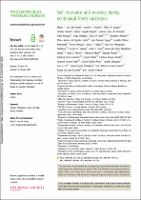| dc.contributor.author | van der Sander, Masha T | |
| dc.contributor.author | Powers, Jennifer S | |
| dc.contributor.author | Norden, Natalia | |
| dc.contributor.author | Salgado Negret, Beatriz | |
| dc.contributor.author | Bongers, Frans | |
| dc.contributor.author | Delgado, Diego | |
| dc.contributor.author | Dent, Daisy H | |
| dc.contributor.author | Dupuy, Juan Manuel | |
| dc.contributor.author | Finegan, Bryan | |
| dc.contributor.author | Jakovac, Catarina C | |
| dc.contributor.author | Meave, Jorge A | |
| dc.contributor.author | Muñoz, Rodrigo | |
| dc.contributor.author | Piotto, Daniel | |
| dc.contributor.author | Cáceres Siani, Yasmani | |
| dc.contributor.author | Sanchez Azofeifa, G. Arturo | |
| dc.contributor.author | Poorter, Lourens | |
| dc.contributor.author | y 15 autores más | |
| dc.date.accessioned | 2022-11-22T19:24:12Z | |
| dc.date.available | 2022-11-22T19:24:12Z | |
| dc.date.issued | 2022-01-24 | |
| dc.identifier.uri | https://repositorio.catie.ac.cr/handle/11554/12147 | |
| dc.description.abstract | The recovery of soil conditions is crucial for successful ecosystem restoration and, hence, for achieving the goals of the UN Decade on Ecosystem Restoration. Here, we assess how soils resist forest conversion and agricultural land use, and how soils recover during subsequent tropical forest succession on abandoned agricultural fields. Our overarching question is how soil resistance and recovery depend on local conditions such as climate, soil type and land-use history. For 300 plots in 21 sites across the Neotropics, we used a chronosequence approach in which we sampled soils from two depths in old-growth forests, agricultural fields (i.e. crop fields and pastures), and secondary forests that differ in age (1–95 years) since abandonment. We measured six soil properties using a standardized sampling design and laboratory analyses. Soil resistance strongly depended on local conditions. Croplands and sites on high-activity clay (i.e. high fertility) show strong increases in bulk density and decreases in pH, carbon (C) and nitrogen (N) during deforestation and subsequent agricultural use. Resistance is lower in such sites probably because of a sharp decline in fine root biomass in croplands in the upper soil layers, and a decline in litter input from formerly productive old-growth forest (on high-activity clays). Soil recovery also strongly depended on local conditions. During forest succession, high-activity clays and croplands decreased most strongly in bulk density and increased in C and N, possibly because of strongly compacted soils with low C and N after cropland abandonment, and because of rapid vegetation recovery in high-activity clays leading to greater fine root growth and litter input. Furthermore, sites at low precipitation decreased in pH, whereas sites at high precipitation increased in N and decreased in C : N ratio. Extractable phosphorus (P) did not recover during succession, suggesting increased P limitation as forests age. These results indicate that no single solution exists for effective soil restoration and that local site conditions should determine the restoration strategies. | es_ES |
| dc.format.extent | 14 páginas | es_ES |
| dc.language.iso | en | es_ES |
| dc.publisher | The Royal Society Publishing | es_ES |
| dc.relation.ispartof | Philosophical Transactions of the Royal Society B | es_ES |
| dc.relation.uri | https://doi.org/10.1098/rstb.2021.0074 | |
| dc.subject | PH | es_ES |
| dc.subject | CARBONO | es_ES |
| dc.subject | CARBON | es_ES |
| dc.subject | FOSFORO | es_ES |
| dc.subject | PHOSPHORUS | es_ES |
| dc.subject | RESILIENCIA | es_ES |
| dc.subject | RESILIENCE | es_ES |
| dc.subject | NITROGENO | es_ES |
| dc.subject | NITROGEN | es_ES |
| dc.subject | DENSIDAD | es_ES |
| dc.subject | DENSITY | es_ES |
| dc.subject | DENSIDAD A GRANEL | es_ES |
| dc.subject | BULK DENSITY | es_ES |
| dc.subject.other | Sede Central | es_ES |
| dc.title | Soil resistance and recovery during neotropical forest succession | es_ES |
| dc.type | Artículo | es_ES |
| dc.creator.id | https://orcid.org/0000-0002-3103-9878 | es_ES |
| dc.creator.id | https://orcid.org/0000-0002-3346-2178 | es_ES |
| dc.creator.id | https://orcid.org/0000-0001-7491-6837 | es_ES |
| dc.identifier.status | openAccess | es_ES |


